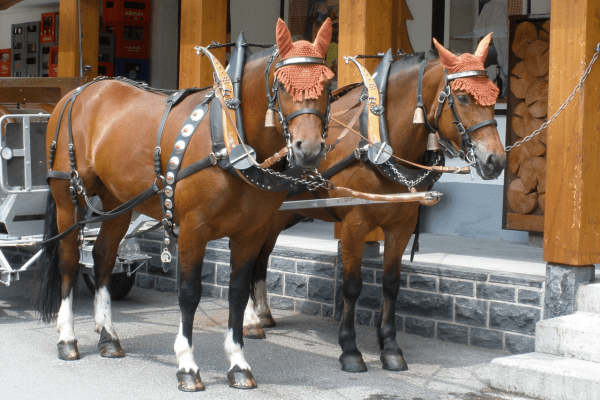The Freiberger, also known as Franches-Montagnes, stands as an embodiment of Switzerland’s rich equine heritage. Originating in Jura Canton – an area in north-western Switzerland known for its natural beauty – this light draught horse breed takes its name from Franches-Montagnes District’s Freiberge or Freiberge District and enjoys great popularity across Switzerland and Belgium as a whole as well.
A truly iconic symbol of Swiss breeding traditions, the Freiberger horse symbolizes functionality combined with elegance to produce exceptional horses.
History:
The Freiberger horse hailing from Switzerland’s Jura region boasts an ancient past brimming with history and tradition. This breed’s development reflects both local needs as well as international influences – making it a distinctive representative of Swiss equestrian culture.
Historical Development
Initial Beginnings: The Freiberger’s journey begins in the Jura region around 1620 when they were initially used for agriculture and postal delivery duties.
Breeding Hub: By the early 19th century, Franches-Montagnes district had become an established breeding center, boasting nearly 4,000 breeding mares by 1817 alone.
Breed Refining Crossbreeding Initiatives:
In an attempt to strengthen the characteristics of this breed, crossbreeding with Anglo-Norman horses began in 1821 and, later on, other European breeds as early as 1830 was undertaken to enhance it. These efforts sought to address perceived shortcomings such as heavy heads and short necks while maintaining robust builds – qualities often perceived as lacking among local varieties.
Nomenclature Evolution
From Regional to Unified Identity: These horses were originally named according to their location of origin before collectively adopting the name ‘Freiberger’ in the late 19th century – unifying all distinct types under a single breed identity.
Cultural Significance
Annual Celebration: Since 1897, Saignelegier’s Marche-Concours des Chevaux has celebrated this breed through an event that combines show, race and market.
Modern Crossbreeding and Preservation
Influence of Swedish Warmbloods: Beginning in the 1970s, crossbreeding between Alsatian studs and Swedish Warmbloods marked a substantial change; nearly half of all breeding population was affected by 1985.
Swiss Warmblood Crossbreeding: In the early 1990s, significant crossbreeding efforts with Swiss Warmblood horses to enhance riding capabilities came to a halt.
Stud-Book and Association Formation: 1960 marked a turning point in breed management with the creation of a stud book which closed to external admixture in 1997, and 1997 also witnessed the establishment of the breed association, Schweizerischer Freibergerverband or Federation suisse d’elevage du cheval de la race des Franches-Montagnes.
Conservation Efforts :
Endangered Original Breed Type: Although overall population levels remain healthy, original breed type with minimal foreign blood contamination remains endangered. A preservation group was organized in 1996, while in 2003 ProSpecieRara and Haras National Suisse at Avenches collaborated to launch a conservation program.
This comprehensive history of the Freiberger horse highlights its rise from local Swiss workhorse to breed of international significance, reflecting both its rich legacy and changing demands of equestrian sports.
Physical Characteristics of Freiberger Horse:
The Freiberger horse, famed for its robust and adaptable nature, boasts numerous physical traits that distinguish and charm it. Here are a few key aspects of its physical profile:
Height: Freibergers typically stand 14.2- 15.2 hands high, placing them into the medium-sized category of horse breeds.
Body Composition: They display a well-muscled yet compact build. Their physique can be identified by broad chest, strong back, and an overall harmonious body structure.
Head: The Freiberger has an elegant head, featuring either a straight or slightly convex profile and expressive yet gentle eyes that reflect its friendly yet calm disposition.
Neck: The neck of this breed features muscularity while also remaining elegantly set, adding to their balanced appearance.
Legs: Their legs feature solid construction with well-defined joints and strong tendons to allow for various terrains and workloads.
Hooves: The hooves of this breed are sturdy and well-formed, reflecting its heritage in mountainous regions where resilience is crucial.

Coat: The Freiberger has an extremely dense and luxurious coat that provides insulation and protection from various weather conditions.
Colors: Common coat colors for this breed include chestnut, bay, and brown; however other hues may also exist. They do not typically exhibit excessive markings or unusual color combinations.
Gait: The Freiberger is well known for its easy and efficient movement. It boasts an elegant gait which displays both agility and strength.
Temperament and Behavior:
One of the hallmarks of Freiberger horses is their gentle temperament. Known for being patient, accepting, and willing, Freiberger horses make excellent horses for riders of all levels, beginners included.
Not to mention being intelligent yet easy to train which makes them popular choices both recreationally and therapeutically.

